| Srl | Item |
| 1 |
ID:
159813
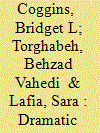

|
|
|
| 2 |
ID:
186454
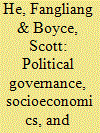

|
|
|
|
|
| Summary/Abstract |
Quantifying the effects of political, socioeconomic, and weather factors on greenhouse gas (GHG) emissions is vital for successful climate change mitigation and adaptation. We modeled these effects on provincial per-capita GHG emissions across Canada from 1990 to 2019. The results showed the percentage of variation in GHG emissions explained by the models ranged from 75.3% to 98.8% across the ten Canadian provinces. Socioeconomics was associated with most of the emission variation (46.1%), followed by weather (1.4%). The effect of political governance on GHG emissions was minor (0.7%) and inconsistent but had a strong interaction with socioeconomic factors. Energy use efficiency was identified to be the most influential factor, contributing to lowering emissions in eight provinces. We conclude that socioeconomic factors are most important in causing GHG emissions across Canada, while the importance of political governance is trivial, much to the chagrin of those making election promises. Investment in energy efficient technologies should have the highest return in reducing emissions.
|
|
|
|
|
|
|
|
|
|
|
|
|
|
|
|
| 3 |
ID:
095002
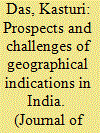

|
|
|
|
|
| Publication |
2010.
|
| Summary/Abstract |
In the recent past, geographical indications (GIs) have emerged as a significant intellectual property rights issue in the Indian context. Since 15 September 2003, when the Indian GI Act came into force, more than a hundred Indian products have been registered as GIs. However, there are several practical challenges confronting the stakeholders in India when it comes to the realization of the potential benefits ingrained in GIs. Apart from effective enforcement of the rights in the relevant markets (domestic and export), the success of a GI is contingent, in a large measure, upon appropriate marketing and promotion of the product-tasks that are not only resource-intensive but also challenging to execute for many stakeholders from a developing country like India. It is all the more tricky to ensure that a fair share of the benefits accruing from the GI status of a product reaches the actual producers/artisans downstream in the supply chain, unless an appropriate institutional mechanism is set in place towards that end. Against this backdrop, the article attempts to explore the prospects for India in exploiting the potential benefits embedded in GIs and the key challenges confronting the country in its endeavour to realize such benefits.
|
|
|
|
|
|
|
|
|
|
|
|
|
|
|
|
| 4 |
ID:
066913


|
|
|
| 5 |
ID:
130852
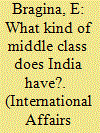

|
|
|
|
|
| Publication |
2014.
|
| Summary/Abstract |
The article examines economic conditions in India and that country's middle class. Conflicting estimates of the population of India's middle class are cited as an indication of the difficulty in estimating economic indicators in developing countries due to the large informal sector of their economies. Economic and social indicators for India including its large percentage of younger adults, urbanization and consumption suggesting India's middle class will increase in size are discussed.
|
|
|
|
|
|
|
|
|
|
|
|
|
|
|
|
| 6 |
ID:
124717
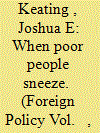

|
|
|
|
|
| Publication |
2013.
|
| Summary/Abstract |
Analysts often borrow from the vocabulary of disease to describe financial crises, using word such as "pandemic" and "contagion" to discussed how economic disturbance spread. But recent research suggests a more literal connection between the two : poor countries, actual disease can infect the financial system.
|
|
|
|
|
|
|
|
|
|
|
|
|
|
|
|